Hadrosaurus
Hadrosaurus (/ˌhædrəˈsɔːrəs/; meaning "bulky lizard") is a genus of hadrosaurid ornithopod dinosaurs that lived in North America during the Late Cretaceous Period in what is now the Woodbury Formation about 80 million to 78 million years ago. The holotype specimen was found in fluvial marine sedimentation, meaning that the corpse of the animal was transported by a river and washed out to sea.
| Hadrosaurus | |
|---|---|
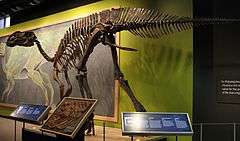 | |
| Reconstructed skeleton, Academy of Natural Sciences | |
| Scientific classification | |
| Kingdom: | Animalia |
| Phylum: | Chordata |
| Clade: | Dinosauria |
| Order: | †Ornithischia |
| Suborder: | †Ornithopoda |
| Family: | †Hadrosauridae |
| Subfamily: | †Hadrosaurinae |
| Genus: | †Hadrosaurus Leidy, 1858 |
| Type species | |
| †Hadrosaurus foulkii Leidy, 1858 | |
| Synonyms | |
| |
They were large animals ranging from 7 to 8 m (23 to 26 ft) and 2 to 4 t (2,000 to 4,000 kg). Most of the preserved elements are very robust, unusual traits in hadrosaurs. Hadrosaurus were ponderously-built animals equipped with keratinous beaks for cropping foliage and a specialized and complex dentition for food processing.
Hadrosaurus foulkii, the only species in this genus, is known from a single specimen consisting of much of the skeleton and parts of the skull. The specimen was collected in 1858 from the Woodbury Formation in New Jersey, US, representing the first dinosaur species known from more than isolated teeth to be identified in North America. Using radiometric dating of bivalve shells from the same formation, the sedimentary rocks where the Hadrosaurus fossil was found have been dated at some time between 80.5 and 78.5 million years ago. In 1858 the only known specimen became the first ever mounted dinosaur skeleton and since 1991 the species H. foulkii has become the official state dinosaur of New Jersey.
History of discovery
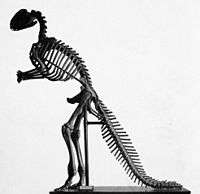
In 1838, John Estaugh Hopkins was digging in a marl pit (on a small tributary of the Cooper River in Haddonfield, New Jersey, and part of the Campanian-age Woodbury Formation) when he uncovered large bones, putting them on display at his home, also in Haddonfield. In 1858, these bones sparked the interest of a visitor, William Parker Foulke. The skeleton was dug out from the marl pit in 1858 by Foulke. The excavation site, known as the Hadrosaurus foulkii Leidy site, is now a National Historic Landmark. Foulke contacted paleontologist Joseph Leidy, and together they recovered 8 teeth from the maxillar and dentary areas, dental battery fragments, left maxilla fragments, 3 partial dorsal vertebrae, 13 caudal centra including an almost complete middle caudal vertebra and other fragments, partial right coracoid, left humerus, left radius, left ulna, left ilium, right ischium, right partial pubis, the left hindlimb composed by the femur, tibia, fibula with metatarsals II and IV and the first pedal phalanx from the third digit. Foulke and Leidy studied the fossils together, and in 1858, Leidy formally described and named Hadrosaurus foulkii in honor of his collaborator. Hadrosaurus is derived from the Greek ἁδρός, hadros, meaning "bulky" or "large", and σαῦρος, sauros, meaning "lizard". Leidy recognized that these bones were from a dinosaur by their similarity to those of Iguanodon, discovered in England some decades before, but at the time, the skeleton of Hadrosaurus was one of the most complete dinosaur skeletons known. Leidy's monograph Cretaceous Reptiles of the United States, describing Hadrosaurus more completely and with illustrations, was written in 1860, but the American Civil War delayed its publication until 1865.[1]
Leidy reconstructed Hadrosaurus as a biped, in contrast to the view at the time that such dinosaurs were quadrupedal. The entire skeleton was completely assembled in 1868 by a team including English sculptor and naturalist Benjamin Waterhouse Hawkins and was put on display at Philadelphia Academy of Natural Sciences. It was the first-ever mounted dinosaur skeleton. When the skeleton was first assembled, it was displayed with a plaster skull sculpted by Hawkins. Many other artists have recreated Hadrosaurus with skulls from other, related species such as Gryposaurus and Brachylophosaurus. A statue of Hadrosaurus, sculpted by Haddonfield resident John Giannotti, now stands in the center of the town of Haddonfield, commemorating its discovery there. Hadrosaurus was named the state fossil of New Jersey, designated in 1994. It is one of the most celebrated dinosaurs ever and is of great historic importance.[1] The skeleton is usually kept 'behind-the-scenes' in the Academy's collections. However, from November 22, 2008, until April 19, 2009, a fully assembled cast of the skeleton and an exhibit about the science and culture surrounding the dinosaur's discovery was open to the public.
Description

Hadrosaurus were large sized animals growing up to 7–8 m (23–26 ft) and weighing as much as 2 to 4 t (2,000 to 4,000 kg).[2][3] According to Prieto-Márquez, Hadrosaurus can be distinguished in having a shortened pectoral crest that is slightly over 40% of the total humeral length, a deltopectoral crest that is developed from the humeral shaft causing the laterodistal border to display a broad lateral facet, a lower greatest point of the supraacetabular crest located above lateral edge from the rear to the bottom on the posterior tuberosity of the ischial peduncle of the ilium, a shortened supraacetabular crest from the front to the rear with its breadth being half the length of the middle iliac plate.[4]
As in most hadrosaurs, the forelimbs were not as heavily built as the hindlimbs, but were long enough to be used in standing or movement.[1][5][3] The holotype specimen was a relatively large animal at the time of death with a 1.05 m (105 cm) long femur and 93.3 cm (933 mm) long tibia. Most of the preserved elements feature a marked robust composition with the fibula being one of the most robust among hadrosaurs.[1]
Classification
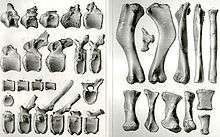
Despite the fact that the family Hadrosauridae has Hadrosaurus as its type genus, the skeleton lacks a skull and was long viewed as too incomplete to compare to other hadrosaurs for classification purposes, leading most scientists to consider it a nomen dubium, or dubious name.[4] However, a re-evaluation of the fossil material in 2011 noted several distinct characteristics of the skeleton that could allow the genus Hadrosaurus and species H. foulkii to remain in use as valid taxa.[4]
Hadrosaurus has also traditionally served as the basis for a large subfamily called Hadrosaurinae, which was seen as a group of largely crestless group of hadrosaurs related to the crested subfamily Lambeosaurinae. However, the changing view of Hadrosaurus classification in relation to other hadrosaurs has led some scientists to rename these subfamilies. In a 2008 study, Hadrosaurus was found to be more primitive than either lambeosaurines or other "hadrosaurines", and not a particularly close relative of classic "hadrosaurines" such as Edmontosaurus and Saurolophus. As a result of this, the name Hadrosaurinae was restricted to Hadrosaurus alone, and the subfamily comprising the traditional "hadrosaurines" was renamed the Saurolophinae.[6]
Below is a simplified cladogram recovered by Ramírez-Velasco et al. in 2012 in their description of Huehuecanauhtlus. This topology was recovered using an extensive sampling of 60 hadrosauroid species, and two outgroup taxa, which were scored based on 287 morphological traits,[7] and included data from two recent redescriptions of Hadrosaurus by Prieto-Márquez et al. (2006)[1] and Prieto-Márquez (2011).[4]
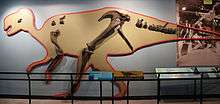
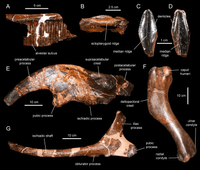
| Hadrosauroidea |
| ||||||||||||||||||||||||||||||||||||||||||||||||||||||||||||||||||||||||||||||||||||||||||||||||||||||||||||||||||||||||||||||||||||||||||||||||||||||||||||
Paleobiology
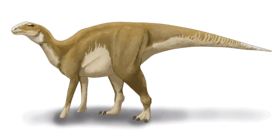
In 2003, Rothschild and colleagues performed a study looking for epidemiology of tumors in dinosaurs. Evidence of tumors, including hemangiomas, desmoplastic fibroma, metastatic cancer, and osteoblastoma were discovered in specimens of Hadrosaurus by analyzing dinosaur vertebrae using computerized tomography and fluoroscope screening. Several other hadrosaurids, including Brachylophosaurus, Edmontosaurus, and Gilmoreosaurus, also tested positive. Although more than 10000 fossils were examined in this manner, the tumors were limited to Hadrosaurus and other hadrosaurs. The tumors were only found on caudal vertebrae and they may have been caused by environmental factors or genetic inheritance.[8]
Paleoecology
The holotype of Hadrosaurus was found in marine sediments, which suggests the skeleton was transported by a river and then deposited in the Cretaceous sea. The Hadrosaurus remains all persist to the Woodbury Formation.[1] Through the radiometric dating of bivalve shells known from the formation, the sedimentary rocks where the holotype specimen of Hadrosaurus was found have been dated from 80.5 million to 78.5 million years ago.[9]
References
- Prieto-Márquez, A.; Weishampel, D. B.; Horner, J. R. (2006). "The dinosaur Hadrosaurus foulkii, from the Campanian of the East Coast of North America, with a reevaluation of the genus" (PDF). Acta Palaeontologica Polonica. 51 (1): 77–98.
- Holtz, T. R.; Rey, L. V. (2007). Dinosaurs: The Most Complete, Up-to-Date Encyclopedia for Dinosaur Lovers of All Ages. Random House. ISBN 9780375824197.CS1 maint: date and year (link) Genus List for Holtz 2012 Weight Information
- Paul, G. S. (2016). The Princeton Field Guide to Dinosaurs (2nd ed.). Princeton, New Jersey: Princeton University Press. p. 330. ISBN 9780691167664.
- Prieto-Márquez, A. (2011). "Revised diagnoses of Hadrosaurus foulkii Leidy, 1858 (the type genus and species of Hadrosauridae Cope, 1869) and Claosaurus agilis Marsh, 1872 (Dinosauria: Ornithopoda) from the Late Cretaceous of North America". Zootaxa. 2765: 61–68. doi:10.11646/zootaxa.2765.1.6.
- Erickson, G. M.; Hamilton, M.; Sawyer., W. G.; Krick, B. A.; Bourne, G. R.; Norell, M. A.; Lilleodden, E. (2012). "Complex Dental Structure and Wear Biomechanics in Hadrosaurid Dinosaurs". Nature. 338 (338 (6103): 98): 98–101. Bibcode:2012Sci...338...98E. doi:10.1126/science.1224495. PMID 23042891.
- Prieto-Márquez, A. (2013). "Skeletal morphology of Kritosaurus navajovius (Dinosauria:Hadrosauridae) from the Late Cretaceous of the North American south-west, with an evaluation of the phylogenetic systematics and biogeography of Kritosaurini". Journal of Systematic Palaeontology. 12 (2): 133–175. doi:10.1080/14772019.2013.770417.
- Ramírez-Velasco, A. A.; Benammi, M.; Prieto-Márquez, A.; Ortega, J. S. A.; Hernández-Rivera, R.; Sues, H. D. (2012). "Huehuecanauhtlus tiquichensis, a new hadrosauroid dinosaur (Ornithischia: Ornithopoda) from the Santonian (Late Cretaceous) of Michoacán, Mexico". Canadian Journal of Earth Sciences. 49 (2): 379–395. Bibcode:2012CaJES..49..379R. doi:10.1139/e11-062.
- Rothschild, B. M.; Tanke, D. H.; Helbling II, M.; Martin, L. D. (2003). "Epidemiologic study of tumors in dinosaurs". Naturwissenschaften. 90 (11): 495–500. doi:10.1007/s00114-003-0473-9. PMID 14610645.
- Gallagher, W.B. (2005). "Recent mosasaur discoveries from New Jersey and Delaware, USA: stratigraphy, taphonomy and implications for mosasaur extinction. Archived 2012-09-04 at the Wayback Machine" Netherlands Journal of Geosciences, 84(3): 241.
External links
| Wikimedia Commons has media related to Hadrosaurus. |
| Wikispecies has information related to Hadrosaurus |
- Hadrosaur mummy
- The discovery of H. foulkii
- Hadrosaurids on UCMP
- Hadrosaurus skeletal diagram
- New Jersey State Museum website
- Joseph Leidy and Hadrodaurus foulkii at The Academy of Natural Sciences
- Hadrosaurus foulkii exhibit at The Academy of Natural Sciences

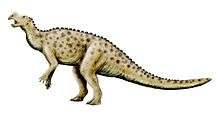

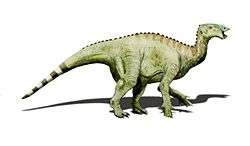
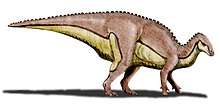
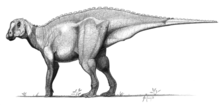
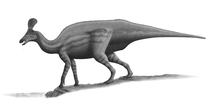
.jpg)